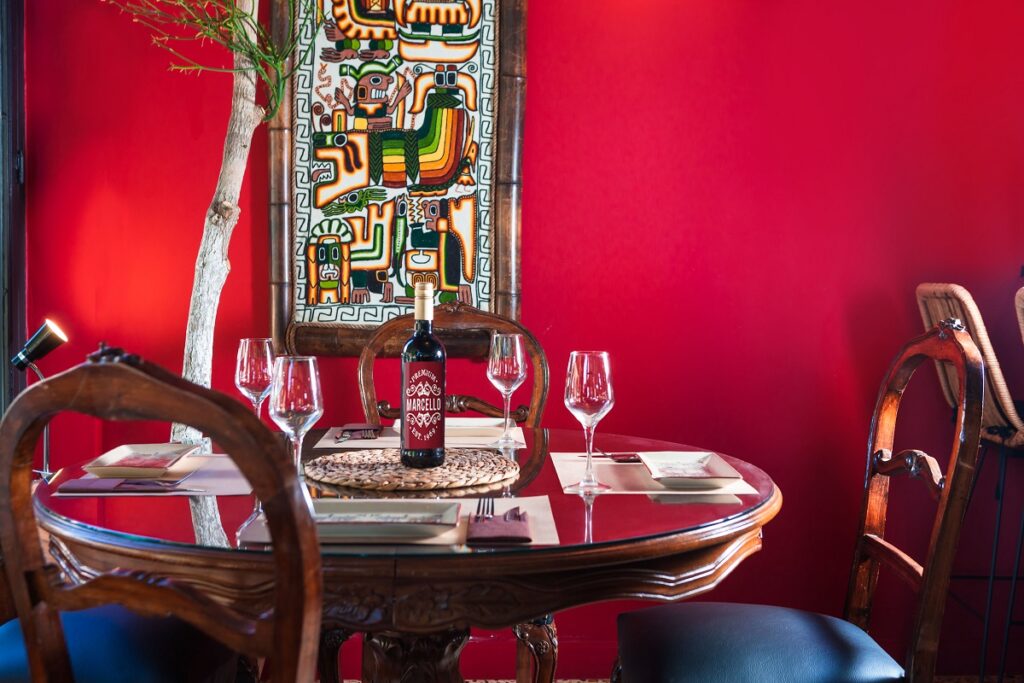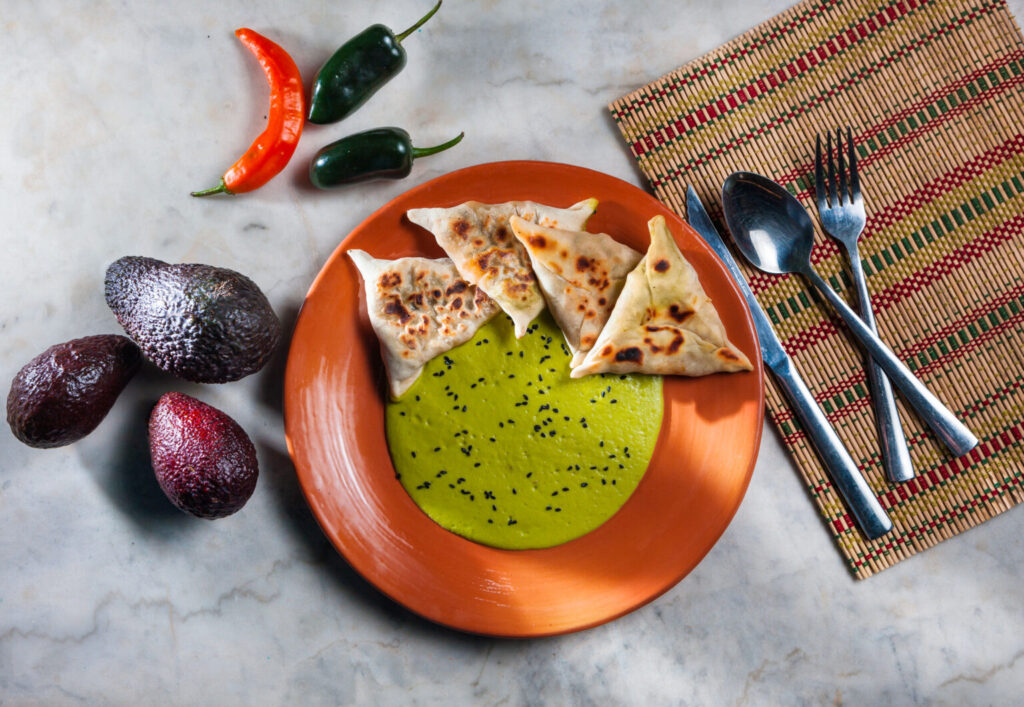Matzenta Kuzina del Sol offers special exotic habits with signature dishes from the spicy regions of Mexico with a unique Cretan twist.
In Chania, Dimitris Malandrenis creates dishes from Mexico to Crete and back…

Text curation: Katerina Karsioti
In Chania and at Matzenta Kuzina del Sol… Dimitris Malandrenis creates dishes from the exotic and spicy regions of Mexico to Crete.
The culinary history under the sun that fits many cultures together on the map serves to your table more than just a recipe. It is a story that unfolds without lines and borders and that in a unique way connects cuisines of the world, connects cultures, people and local products that are all looking for their own fellow travellers.
Chania is the point-place where two culinary travel destinations meet and talk, exchange ideas and create, generously offering a whole world that you enjoy in your plate..
At Matzenta in Chania you discover, taste and enjoy dishes from a brigade that never stops smiling and creating under the same sun, through which we grow and mature with a single purpose, human communication.
Dimitris Malandrenis is the figure behind this culinary proposal, he is the man who confects dishes from Mexico to Crete and back with great passion and unbounded love. He stems from Chania and eventually found himself on the streets of Mexico. Not by accident, but all of a sudden. For three consecutive years, he studied traditional Mexican cuisine and slowly began to understand an entire culture. Because, as he reports, you understand people better through their gastronomy.
The cuisine at Matzenta Kuzina del Sol is essentially a large and bright bridge from the Pacific to the Cretan Sea transporting memories, common culinary ingredients and multicultural flavors.

How did you “bridge” Mexico and Crete in the same dishes?
I still recollect the moment on the beach of Oaxaca, in Mazunte one afternoon, watching the sun set in the Pacific and traveling west of Crete, to my beloved Sfinari. Just like the afternoons in Chania, on my return from the sea I found treating myself a flavorful tomato, cut in half with local oregano and sea salt. Tomatoes, let’s remember, were produced in Mexico and combined with one of the main ingredients of Mexican cuisine, oregano. More spicy than ours, but with oregano.
In our tavern Matzenta Kuzina del Sol we prepare recipes inspired by traditional Mexican dishes and are presented with a Cretan perspective. As well as the opposite, for example, one of our classic winter dishes is the local beef slow-cooked in the stew with chestnuts exactly like the stew we can find in the mountain villages of Crete but we bring it to Mexico through the classic adobo (sauce) of Ancho peppers & Guajillo. Other times we prepare recipes from Mexico that use the exact same ingredients as traditional Cretan cuisine. After all, we always love to “play” culinary games between my two favorite destinations.
A stroll outside the kitchens of Mexico… is in itself a walk into a whole world
The cuisine… is not merely recipes, raw materials and techniques, it is a whole concept where wallow traditions, cultures, memories, faces, stories. A “book” with countless pages that never stops. The epilogue may not exist, it may even be the final taste on your palate. The kitchen is an entire “communication”, it is a storyline within a story. It reflects trends, suggestions and feelings.
In Mexico the flavors you will savour do not acquire one identity but many. They are as diverse as the influences deriving from the traditions of the Aztecs, the Mayans, the Spanish. Depending on the region, there is something unique to try. The aromas are intense, sparkling and the wide variety of spices used orchestrate dishes with incredible interest.
No hay maíz, no hay país…. A phrase that essentially shows the enormous importance of corn in the diet of Mexicans. Peppers and beans, too, were the vegetables that the locals raised their families for many years until the Spanish came who, of course as conquerors, formed a new gastronomy resulting in adapting recipes with new ingredients and techniques. With traditional Mexican cuisine finally being completed by the French and then the Lebanese.
A journey to the cuisine of Northern Mexico means mainly beef and goat recipes, while in the Southeast where the influence of the Caribbean is strong, there is an abundance of seafood on your table. You can also take delight in the authentic barbaca, pozole, menudo, carnitas dishes in the regions of Central Mexico with your suitcase full as you say goodbye to all these delicious and exotic memories with a truly experiential culinary experience.

Are there products grown at both points which are integrated in your recipes?
First let’s point out that, Crete comes at 2nd place in regards to latitude after Mexico. This alone gives us the same climatic characteristics, therefore the same cultivation conditions. It is no coincidence that olive oil is produced in Baja California. But in Mexico and Crete there are so many products reminding us how close we are, such as avocados, mangoes, prickly pears, pumpkin flowers, fresh myzithra, marjoram, oregano, tomato, wild mountain greens and so many but so much more.
An important element of the so-called bridge is also the cooking techniques used together, such as stews in pots, roasts in greaseproof paper, and even the traditional barbacoa oven we use in our tavern, which is essentially cooking inside the earth, it has a connection to the way shepherds would roast meat in hiimadia (places in the lowlands that shepherds used to hibernate with their flocks) all night.
The impressive thing is that at Matzenta Kuzina del Sol you experience in real time all the culinary habits of Mexicans “wedding” essentially with Cretan tradition and cuisine. With original and unprecedented combinations, but with familiar and uniquely combined raw materials. With the element of surprise appearing every single time at your table and with the menu being creative and different from what you are used to. After all, this is what a trip is all about… Constantly discovering new “places” and new “habits”.
5 kilometers from Chania in a village called Mournies, Dimitris Malandrenis owns his own field, cultivated organically from where he supplies all the basic products for his recipes. All the ingredients used at the restaurant come from small local producers within a radius of a few kilometers.
Furthermore, on Matzenta’s “agenda” is a Zero Waste policy, where the team cooks everything from squeezed lemon wedges to fish bones and heads. This contributes significantly in reducing wastage of materials and waste and in raising awareness for a better environment. After all, sustainable gastronomy is an important key to protecting our planet.

How important and unique it is to use raw materials according to the season…
In my village, Nerokourou, the colors of the blossoms of the avocado and mango trees flood your heart every April when they mingle with the green of the olive. This picture often makes you cry filled with emotions, it is truly inspiring. We welcome every season and the goodies that bring along to Crete with great joy. I would mention that we look forward to the fall rains and wild greens in our recipes, the arrival of spring the wild mushrooms, the delicious mangoes and chirimoyas during the summer.
Our menu, with the few dishes, changes daily based on what the field will produce, the fishermen bring us fresh fish and this occurs to get the maximum from the flavor of each ingredient we use. Raw material is what guides us to make a recipe and is not defined by the recipe itself…
A culinary wave from the exotic regions of Mexico comes and inhabits Cretan land, shaping a multicultural taste effect. A coexistence that is at least charming and sunny, a partnership that embraces cultures and aromas, a cuisine, that of Matzenta, which is not defined as Mexican or Cretan, but as a cuisine of the sun, as chef Dimitris Malandrenis so eloquently described.
What more do you expect from a dish…? I imagine to communicate, to try, to share.
Certainly at Matzenta Kuzina del Sol, in addition to enjoying wonderful dishes from Mexico to Crete and back, you will get closer to people you love, you will get to know other and exotic culinary trends, you will travel to distant flavors and under the same sun, you will once again plan your trip at a common table which by itself anyhow takes you around the world…

Barbacoa: Travelling to the Authentic Culinary Ritual of the Mexicans
a unique proposal…and in Greek soil!
If you are a fan of Mexican gastronomy, the time has come to unravel a secret hidden deep within the earth. It’s called Barbacoa and it’s the traditional Mexican oven, an one of a kind rite of passage.

An entire storytelling “dresses up” your dishes with the Barbacoa oven process
The impressive thing is that sometime in the 19th century it was common to use Barbacoa during the autumn and winter seasons because of the heat, which was ideal to cope with the cold.
The term “barbacoa” refers to the traditional method of preparing a wide variety of meats and its origins are pre-Columbian. In essence, it is a well in the ground that serves as an oven for cooking the respective meat.
The origin of its name is neither Spanish nor originated from any indigenous language, however, as early as the 18th century dictionaries, it was used for this particular cooking process. It is worth noting that barbacoa is associated significantly with the consumption of lamb, whether in tacos, flautas and other appetizers, often accompanied by consol.
This technical cooking method was mainly used for meat, with banana and agave leaves imparting a unique aroma. At the same time, oak, as the main and ideal firewood in the “barbacoa” technique, is an element that should not be missing, as it grants the final result of the meat splendid taste.
A typical dish is getting set according to this traditional technique is the Coahuila, with which Mexicans celebrate their weddings, as well as Christmas and New Year’s holidays.
Preparing the traditional barbecue takes a whole day… from digging the 1.5 meter deep hole to collecting the meat and its juices. Mexican weekends are “scheduled” around the ritual of the barbacoa oven with recipes and dishes according to its technique.

Barbacoa… Something more than a dish
The preparation of the dish before you “welcome” it to your table and introduces you to a whole story, will literally cast a spell on you.
A basic condition for using the Barbacoa oven is to dig a hole in the ground approximately 80 cm in diameter and 1.5 meters deep. Stones or firebricks are placed around its walls to light the fire, which burns and “accompanies” you for over 2 hours.
The metal vessel, which is placed right on the base after the fire is well lit, is filled with plenty of water and a bunch of herbs. Mexicans traditionally use chickpeas, epazote – their well-known herbs, onion and tomato, which are simmered along with the meat. As for the latter, it is most often the so-called Borrego, a type of lamb aged around 2 years with quite exceptional fat.
An important step of the technique is to wrap the meat in agave leaves (pencas de maguey), also known in Greece as Athanatos (agave americana), which imparts unique aromas. Somewhere at the end, the oven is covered with the metal container and its gaps around with soil. At this point the meat is essentially steamed for over 10 hours with high heat slowly dismembering it.
Barbacoa… with the aura of Crete
And yet, in Crete you experience in real time the traditional habits of the Mexicans. In Chania and Matzenta Kuzina del Sol, the barbacoa oven passes before your eyes, giving you the opportunity to enjoy before your eyes one of the most authentic Mexican rituals.
The oven is made with Cretan firebricks as Chef Dimitris Malandrenis narrates, over 100 years old from the area of Agia Marina, a spot a few kilometers outside the city.
In this traditional barbecue, free-range meat with the smell of olive wood is roasted daily in combination with strong Cretan herbs such as marjoram & fresh lovage to slow-roast for over 8 hours the organic pork of the Vavouraki farm, as well as the wild goats and sheep from the mountains of Crete. Shortly before it reaches your table, meat is wrapped in fresh Cretan banana leaves to acquire an even fresher sweetness following a unique culinary experience.
From the exotic regions of Mexico, the Barbacoa bakery resides in Cretan land, reminding you that you get to know people better through their gastronomy.





